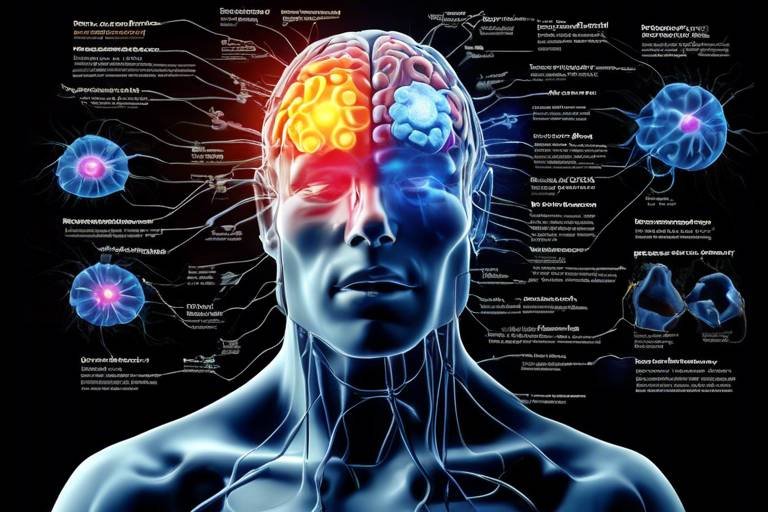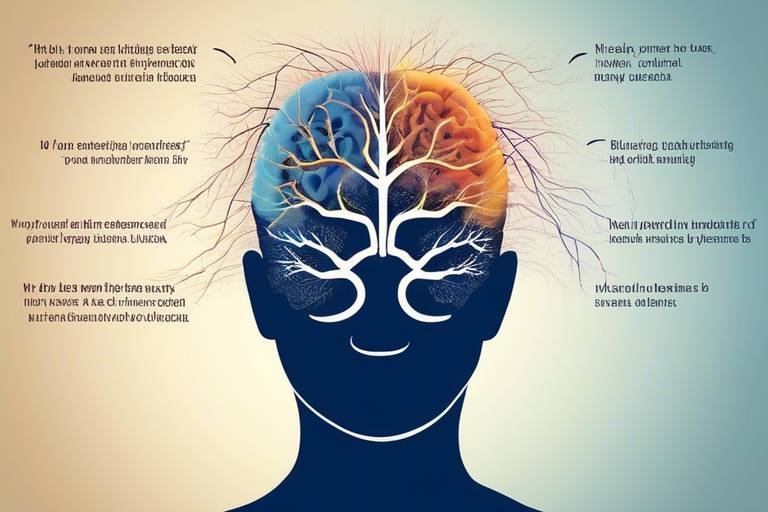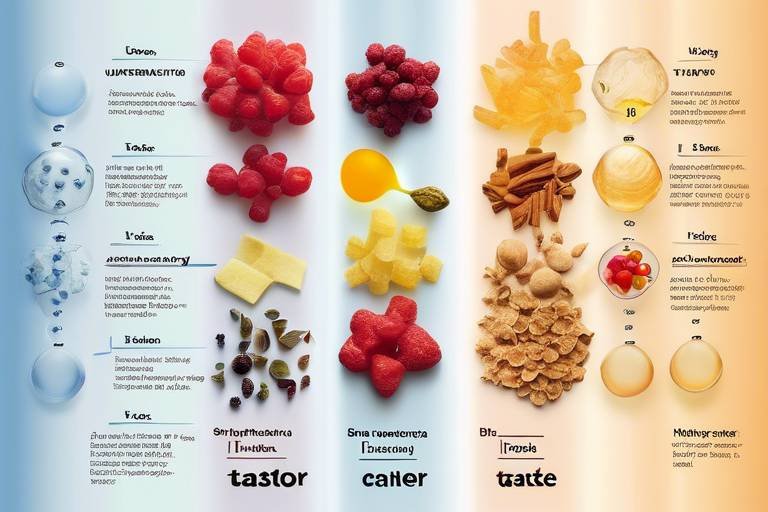The Science of Team Dynamics - How Collaboration Works
In today’s fast-paced world, the ability to collaborate effectively is more vital than ever. Team dynamics can be likened to the intricate gears of a well-oiled machine; when they work in harmony, the outcome is nothing short of extraordinary. But what exactly is team dynamics? It encompasses the psychological and social interactions among team members, shaping how they communicate, collaborate, and ultimately achieve their goals. Understanding these dynamics is essential not just for enhancing productivity, but also for fostering a culture of innovation and strengthening interpersonal relationships.
Imagine a sports team where each player knows their role and trusts one another; they communicate seamlessly, anticipate each other's moves, and adapt to changing situations. This is the essence of effective team dynamics. When team members feel valued and understood, they are more likely to contribute their ideas and efforts, resulting in a synergistic effect that can propel the team to new heights. In contrast, a team with poor dynamics may struggle with miscommunication, conflict, and a lack of direction, leading to frustration and disengagement.
At the heart of successful collaboration lies the interplay of various factors, including communication styles, leadership approaches, and individual personalities. Each of these elements plays a significant role in shaping the team's environment and determining how well they can work together. For instance, consider how different communication styles—whether assertive, passive, or aggressive—can influence interactions. A team that embraces diverse communication methods is better equipped to navigate challenges and leverage the strengths of its members.
Moreover, the role of leadership cannot be overstated. Effective leaders act as catalysts for positive team dynamics, fostering an atmosphere of trust and support. They encourage open dialogue, celebrate successes, and provide constructive feedback, which in turn empowers team members to take risks and share their insights. This nurturing environment not only enhances collaboration but also drives innovation, as team members feel safe to propose bold ideas without fear of judgment.
In summary, the science of team dynamics is a fascinating exploration of how collaboration works. By understanding the underlying mechanisms that influence team interactions, organizations can create a culture that values teamwork, enhances performance, and ultimately leads to greater success. As we delve deeper into the key factors affecting team dynamics, we will uncover practical strategies for building trust and fostering effective collaboration.
- What are team dynamics? Team dynamics refer to the psychological and social interactions among team members that influence how they work together.
- Why are team dynamics important? They are crucial for enhancing productivity, fostering innovation, and strengthening interpersonal relationships within teams.
- How can I improve team dynamics? Improving team dynamics can involve enhancing communication, building trust, and encouraging open dialogue among team members.
- What role does leadership play in team dynamics? Leadership significantly influences team dynamics by fostering an environment of trust and support, enabling better collaboration.

The Importance of Team Dynamics
Understanding team dynamics is crucial for any organization aiming to thrive in today's fast-paced work environment. Just like a well-oiled machine, every part of a team needs to function smoothly to achieve the desired outcome. Team dynamics shape how individuals interact, communicate, and work together towards common goals. When these dynamics are positive, they can lead to increased productivity, enhanced creativity, and greater job satisfaction among team members.
Imagine a basketball team; if players don't understand each other's strengths and weaknesses, they won't be able to pass the ball effectively or execute plays successfully. Similarly, in a workplace, poor team dynamics can lead to misunderstandings, conflict, and ultimately, failure to meet objectives. On the flip side, effective collaboration can create a vibrant environment where ideas flow freely, and innovation thrives.
Moreover, the importance of team dynamics extends beyond just achieving goals. It influences the overall culture of the organization. A team that communicates well and trusts each other fosters a culture of collaboration and support. This culture not only attracts talent but also retains it, as employees feel valued and engaged in their work.
To illustrate this point further, let's take a look at some of the key benefits of strong team dynamics:
| Benefit | Description |
|---|---|
| Enhanced Communication | Open lines of communication lead to fewer misunderstandings and a more cohesive team environment. |
| Increased Productivity | When team members work well together, tasks are completed more efficiently, leading to higher productivity levels. |
| Boosted Morale | A supportive team atmosphere contributes to higher job satisfaction and morale among employees. |
| Innovation | Collaboration encourages creative problem-solving and the generation of new ideas. |
In conclusion, the significance of team dynamics cannot be overstated. Organizations that prioritize understanding and improving these dynamics will not only see better performance but also cultivate a more engaged and satisfied workforce. The journey towards fostering effective team dynamics requires effort and intention, but the rewards are well worth it.
- What are team dynamics? - Team dynamics refer to the behavioral relationships between members of a team, influencing how they work together.
- Why are team dynamics important? - They are essential for effective communication, productivity, and overall team performance.
- How can we improve team dynamics? - By fostering open communication, building trust, and encouraging collaboration among team members.

When we talk about team dynamics, we're diving into a complex web of interactions that defines how a group functions together. It's not just about the tasks at hand; it's about the people involved and how their unique traits and behaviors shape the collaborative environment. Several key factors play a pivotal role in influencing these dynamics, including communication styles, leadership approaches, and the diverse personalities that each member brings to the table. Understanding these elements can be the difference between a team that thrives and one that merely survives.
First and foremost, communication styles are crucial. Imagine a team like a well-oiled machine; if one part isn’t functioning correctly, the whole system can grind to a halt. Different individuals communicate in various ways—some are direct and to the point, while others might prefer a more nuanced approach. Recognizing and adapting to these styles can lead to smoother interactions. For instance, a team member who thrives on detailed discussions may feel sidelined if others prefer quick, bullet-point updates. This mismatch can create misunderstandings and lead to frustration.
Next, let’s talk about leadership. The leader’s approach can set the tone for the entire team. A leader who promotes an inclusive atmosphere encourages team members to share their thoughts and ideas openly. This not only fosters a sense of belonging but also drives innovation. On the flip side, a more authoritarian leadership style can stifle creativity and make team members hesitant to contribute. It’s like a garden; if you provide the right conditions—sunlight, water, and nutrients—plants will flourish. Similarly, a supportive leader cultivates a thriving team environment.
Moreover, individual personalities significantly impact team dynamics. Each member brings their unique perspective and work style, which can either complement or clash with others. For example, a team with a mix of extroverts and introverts can benefit from diverse viewpoints, but it can also lead to tension if not managed properly. It's essential for team members to recognize and appreciate these differences. Acknowledging each person’s strengths can create a balanced team where everyone feels valued.
In addition to these factors, it’s vital to consider how team cohesion is influenced by shared values and goals. When team members align on their objectives, they are more likely to collaborate effectively. This alignment can be achieved through regular discussions about the team's mission and values, ensuring that everyone is on the same page. A team that understands its purpose is like a ship with a clear destination; it sails smoothly toward its goals.
To sum it up, the dynamics of a team are shaped by a multitude of factors, each interlinked and influential. By understanding and addressing communication styles, leadership approaches, and individual personalities, teams can enhance their collaboration and overall effectiveness. After all, a well-functioning team is not just about getting the job done; it's about creating an environment where everyone can thrive together.
- What are team dynamics? - Team dynamics refer to the psychological and behavioral processes that occur within a team, influencing how members interact and work together.
- Why are communication styles important in teams? - Different communication styles can either facilitate effective collaboration or lead to misunderstandings, making it essential for team members to adapt their methods accordingly.
- How does leadership affect team dynamics? - Effective leadership fosters an environment of trust and support, enabling team members to collaborate more freely and contribute to shared objectives.
- What role does trust play in team dynamics? - Trust is fundamental in promoting open communication, encouraging risk-taking, and enhancing overall team performance.

Effective communication is the backbone of successful teamwork. It's like the oil that keeps the gears of collaboration running smoothly. When team members communicate well, they can share ideas, resolve conflicts, and build relationships that foster a productive environment. However, not everyone communicates in the same way, and understanding these different styles is essential for any team looking to enhance their dynamics. There are generally four primary communication styles: assertive, passive, aggressive, and passive-aggressive. Each style has its own strengths and weaknesses, and recognizing these can help teams navigate interactions more effectively.
For instance, assertive communicators express their thoughts and feelings openly while respecting others. This style is often seen as the most effective because it promotes clarity and honesty. On the other hand, passive communicators may struggle to express their needs, often leading to misunderstandings or resentment. Aggressive communicators, while direct, can create a hostile environment, making others feel undervalued or attacked. Lastly, passive-aggressive communicators may mask their true feelings, leading to confusion and frustration within the team.
To illustrate these styles further, consider the following table that outlines key characteristics of each communication style:
| Communication Style | Characteristics | Potential Impact on Team Dynamics |
|---|---|---|
| Assertive | Clear, direct, respectful | Promotes open dialogue and trust |
| Passive | Avoids conflict, indirect | May lead to unresolved issues |
| Aggressive | Hostile, confrontational | Creates tension and fear |
| Passive-Aggressive | Indirect hostility, sarcasm | Causes confusion and mistrust |
Understanding these styles is crucial because it allows team members to adapt their communication methods to suit the needs of the group. For example, if a team member recognizes that another prefers assertive communication, they can adjust their approach to be more direct and clear, thereby reducing the chance of misunderstandings. This adaptability can significantly enhance collaboration, as it fosters an environment where everyone feels heard and respected.
In summary, recognizing and adapting to different communication styles can be a game-changer for teams. By fostering an atmosphere of understanding and respect, teams can not only improve their collaboration but also create a more positive and productive work environment. So, the next time you're in a team setting, take a moment to observe how your colleagues communicate and consider how you can adjust your style to enhance the overall dynamic. After all, effective communication is not just about speaking; it’s about connecting.

When it comes to teamwork, communication is the lifeblood that keeps everything flowing smoothly. But did you know that there are two main types of communication that play a crucial role in how we connect with our teammates? That's right! Verbal and non-verbal communication are both essential, yet they serve different purposes and can significantly impact the dynamics of a team.
Verbal communication includes the words we speak and the tone we use. It's the direct exchange of ideas, thoughts, and feelings through spoken or written language. Think of it as the surface layer of communication—what you say can clarify intentions and directions. For instance, during a team meeting, a member might say, "I believe we should prioritize this project because it aligns with our goals." This clear statement provides direction and encourages discussion.
On the other hand, non-verbal communication encompasses everything that isn't explicitly said. This includes body language, facial expressions, gestures, and even the physical distance between team members. It's like the underlying current of communication—often, what you don't say speaks louder than your words. For example, if a team member crosses their arms while someone is presenting an idea, it might indicate resistance or discomfort, even if they haven’t voiced any objections. This is why being attuned to non-verbal cues is just as important as what’s being said.
To illustrate the differences further, consider this table:
| Type of Communication | Characteristics | Impact on Team Dynamics |
|---|---|---|
| Verbal Communication |
|
Encourages clarity and direction, fosters open dialogue |
| Non-Verbal Communication |
|
Builds rapport, indicates comfort levels, can lead to misunderstandings if ignored |
In the grand scheme of team dynamics, both verbal and non-verbal communication are intertwined. A team member might verbally express excitement about a project, but if their body language suggests disinterest, it creates a confusing situation. This is where the importance of aligning both types of communication comes into play. Effective teams are those that can not only articulate their thoughts clearly but also read the non-verbal signals of their teammates. This alignment fosters an atmosphere of trust and openness, allowing for a more cohesive team environment.
In conclusion, understanding the balance between verbal and non-verbal communication can dramatically enhance how teams operate. By paying attention to both what is said and what is left unsaid, team members can cultivate a more collaborative and supportive atmosphere. So next time you're in a meeting or working on a project, remember: communication is more than just words—it's a dance of expression that can either bring a team together or drive them apart.
- What is the difference between verbal and non-verbal communication?
Verbal communication involves spoken or written words, while non-verbal communication includes body language, gestures, and facial expressions. - How can I improve my non-verbal communication skills?
Pay attention to your body language, maintain eye contact, and be aware of facial expressions to ensure they align with your verbal messages. - Why is non-verbal communication important in a team?
Non-verbal cues can convey emotions and attitudes that words may not express, helping to build rapport and understanding among team members.

Active listening is not just about hearing words; it's about truly engaging with the speaker and understanding their message. This technique is essential in fostering a collaborative environment where team members feel valued and heard. By practicing active listening, you can significantly enhance team dynamics and improve overall communication. So, how can you become an active listener? Here are some key techniques to consider:
First and foremost, maintaining eye contact is crucial. It shows that you are focused and interested in what the other person is saying. Think of it as a spotlight shining on the speaker, illuminating their thoughts and feelings. Additionally, nodding and using verbal affirmations like "I see" or "Go on" can encourage them to continue sharing. These small gestures create a supportive atmosphere that promotes open dialogue.
Another effective technique is summarizing what you've heard. After the speaker finishes, take a moment to paraphrase their main points. This not only demonstrates that you were listening but also clarifies any misunderstandings. For example, you might say, "So, if I understand correctly, you're suggesting that we should prioritize our tasks differently?" This technique helps solidify the connection and ensures everyone is on the same page.
Asking clarifying questions is another powerful tool in active listening. If something isn't clear, don't hesitate to inquire further. Questions like "Can you elaborate on that?" or "What do you mean by...?" show that you are genuinely interested in understanding their perspective. This approach fosters a culture of curiosity and respect within the team.
Lastly, be aware of your own body language. Your posture, facial expressions, and gestures all contribute to how your message is received. Aim to convey openness and attentiveness. For instance, leaning slightly forward can signal that you are engaged and eager to hear more. Remember, effective communication is a two-way street, and your non-verbal cues play a significant role in how your team members perceive your interest and involvement.
In conclusion, by incorporating these active listening techniques into your daily interactions, you can create a more collaborative and productive team environment. Active listening not only enhances understanding but also builds stronger relationships among team members, paving the way for greater innovation and success.
- What is active listening? Active listening is a communication technique that involves fully concentrating, understanding, responding, and remembering what is being said.
- Why is active listening important in teams? It fosters better communication, enhances collaboration, and builds trust among team members.
- How can I improve my active listening skills? Practice techniques such as maintaining eye contact, summarizing, asking clarifying questions, and being mindful of your body language.

Leadership is not just about giving orders and expecting compliance; it’s a dynamic force that shapes the very fabric of team dynamics. The way a leader interacts with their team can either create a thriving environment or lead to a toxic atmosphere. Think of a leader as a gardener; they must nurture their team, providing the right conditions for growth and collaboration. When leaders embody qualities such as empathy, vision, and decisiveness, they set the stage for a culture where team members feel valued and motivated.
One of the most significant aspects of effective leadership is the ability to foster an environment of trust and support. When team members believe that their leader has their best interests at heart, they are more likely to engage openly and contribute their ideas without fear of judgment. This creates a ripple effect—team members start to trust one another, leading to enhanced collaboration. In contrast, when leadership is characterized by micromanagement or lack of transparency, team dynamics can suffer, resulting in disengagement and reduced productivity.
Moreover, effective leaders are skilled at recognizing the unique strengths and weaknesses of their team members. By understanding individual personalities and communication styles, leaders can tailor their approach to maximize each member's potential. For instance, a leader might notice that one team member thrives on public recognition, while another prefers private praise. By adapting their leadership style to meet these needs, leaders can enhance motivation and performance across the board.
Leadership also plays a crucial role in setting clear goals and expectations. When a leader articulates a shared vision, it aligns the team’s efforts and fosters a sense of purpose. This alignment is essential for collaboration, as it helps team members see how their individual contributions fit into the larger picture. Without this clarity, team members may feel lost or disconnected from the team’s objectives, leading to confusion and inefficiency.
In addition, leaders can model effective communication practices, which are vital for healthy team dynamics. By demonstrating how to provide constructive feedback, engage in active listening, and navigate conflicts, leaders can equip their teams with the tools they need to communicate effectively. This not only enhances collaboration but also helps to cultivate a culture of continuous improvement where team members feel encouraged to share ideas and challenge each other in a respectful manner.
In summary, leadership is a pivotal element in shaping team dynamics. By fostering trust, recognizing individual strengths, setting clear goals, and modeling effective communication, leaders can create an environment that not only enhances collaboration but also drives innovation and success. As teams navigate the complexities of modern work environments, the role of leadership becomes even more critical in ensuring that dynamics remain positive and productive.
- What are the main qualities of an effective leader? Effective leaders are empathetic, decisive, and transparent. They inspire trust and foster collaboration within their teams.
- How can trust be built within a team? Trust can be built through transparency, accountability, and shared experiences. Regular team-building activities and open communication also help in establishing trust.
- Why is communication important in team dynamics? Communication is essential as it facilitates understanding, reduces misunderstandings, and enhances collaboration among team members.
- What impact does leadership style have on team performance? Leadership style directly influences team morale, engagement, and productivity. A supportive and inclusive style tends to yield better results.

Trust is the bedrock upon which successful teams are built. Imagine a bridge: without solid foundations, it can’t withstand the weight of traffic. Similarly, in a team, if trust is shaky, the collaboration can falter, leading to misunderstandings and conflicts. Establishing trust among team members is essential, as it promotes open communication, encourages risk-taking, and ultimately enhances overall team performance. When team members trust one another, they feel more comfortable sharing their ideas and feedback, which can lead to innovative solutions and a more cohesive work environment.
One of the most effective ways to build trust is through transparency. When team members are open about their goals, challenges, and expectations, it creates a culture of honesty. This transparency can be achieved through regular check-ins and updates, where everyone shares their progress and hurdles. Additionally, fostering a sense of accountability is crucial. When individuals take responsibility for their actions and decisions, it reinforces the idea that each member is committed to the team's success. This commitment can be further strengthened by sharing experiences, whether through team-building activities or collaborative projects, which allow members to bond and understand each other's strengths and weaknesses.
To illustrate the importance of trust in team dynamics, consider the following table:
| Trust Level | Impact on Collaboration | Team Performance |
|---|---|---|
| Low Trust | Increased misunderstandings, reluctance to share ideas | Poor performance, missed deadlines |
| Moderate Trust | Some collaboration, occasional sharing of ideas | Average performance, inconsistent results |
| High Trust | Open communication, free exchange of ideas | Excellent performance, innovative solutions |
As shown, the level of trust within a team directly correlates with its ability to collaborate effectively. High levels of trust not only foster a positive atmosphere but also lead to improved creativity and problem-solving capabilities. When team members feel secure in their relationships, they are more likely to take risks and think outside the box, ultimately driving the team toward success.
In conclusion, building trust within teams is not just a nice-to-have; it’s a necessity for achieving high performance and fostering innovation. By focusing on transparency, accountability, and shared experiences, teams can create a safe space for collaboration where everyone feels valued and heard. So, how can you start building trust in your team today? It might just be the key to unlocking your team's full potential!
- What are some quick ways to build trust in a new team?
Start with open communication, share personal stories, and encourage team-building activities to foster connections.
- How can I rebuild trust after a conflict?
Address the issue openly, apologize if necessary, and work together to find a resolution. Transparency is key!
- Can trust be measured?
While trust is subjective, surveys and feedback can provide insights into the team’s trust levels and areas for improvement.

Building trust within a team is not just a nice-to-have; it's a critical necessity for achieving high performance and fostering a collaborative environment. Trust can be likened to the glue that holds a team together, allowing members to share ideas freely and feel secure in their roles. But how do we cultivate this essential ingredient? There are several strategies that can be implemented to create a trusting atmosphere.
First and foremost, transparency plays a pivotal role in trust-building. When team members are open about their goals, challenges, and even mistakes, it cultivates an environment where everyone feels safe to express themselves. This openness can be achieved through regular check-ins and updates, where team members share not just successes but also areas where they need support. For example, consider holding weekly meetings where everyone discusses their current projects and any hurdles they are facing. This practice not only fosters transparency but also encourages collective problem-solving.
Another effective strategy is to promote accountability. When team members hold themselves and each other accountable, it reinforces the idea that everyone is working towards a common goal. This can be achieved by setting clear expectations and deadlines, and by recognizing individuals for their contributions. A simple recognition board can be a fun and engaging way to celebrate achievements, big or small. Imagine a space where team members can post notes of appreciation for their colleagues—this not only boosts morale but also strengthens the bonds of trust.
Moreover, shared experiences can significantly enhance trust among team members. Engaging in team-building activities, whether they are work-related or purely social, can create lasting memories and deepen relationships. For instance, consider organizing a team retreat or even a casual lunch where everyone can unwind and connect on a personal level. These experiences allow team members to see each other beyond their professional roles, fostering empathy and understanding.
To summarize, building trust within a team involves:
- Promoting transparency through open communication.
- Encouraging accountability among team members.
- Creating shared experiences that strengthen relationships.
Implementing these strategies can lead to a more cohesive and high-performing team. Remember, trust doesn’t develop overnight; it’s a gradual process that requires consistent effort and commitment from every team member. By prioritizing trust-building, teams can unlock their full potential and achieve remarkable results together.
Q: How long does it take to build trust within a team?
A: Building trust is a gradual process that can take weeks to months, depending on the team dynamics and the commitment of its members.
Q: What are some signs that trust is lacking in a team?
A: Signs of low trust can include poor communication, lack of collaboration, and increased conflict among team members.
Q: Can trust be rebuilt once it’s broken?
A: Yes, while it may take time and effort, trust can be rebuilt through consistent transparency, accountability, and open communication.

Trust is often described as the glue that holds a team together. When team members trust one another, collaboration becomes not just easier, but also more enjoyable. Imagine a group of musicians playing together; when they trust each other, they can improvise, create, and build upon each other's ideas, leading to a harmonious performance. In a similar vein, trust in a team allows individuals to feel secure enough to share their thoughts and suggestions without fear of judgment.
High levels of trust foster an environment where team members are more likely to engage in open dialogue. This openness is crucial because it encourages the free flow of ideas, which can lead to innovative solutions. When people feel that their contributions are valued, they are more inclined to participate actively in discussions. This can be illustrated in a workplace setting where brainstorming sessions become vibrant and productive, rather than stifled by hesitation and fear of criticism.
Moreover, trust enhances the willingness to take risks. In a trusting environment, team members are more likely to experiment with new ideas or approaches. They understand that even if a particular idea doesn't pan out, the team will support one another rather than pointing fingers or assigning blame. This collective mindset can significantly boost creativity and problem-solving capabilities, as team members are not afraid to step outside their comfort zones.
To further illustrate the impact of trust on collaboration, consider the following table that outlines the differences in team dynamics based on trust levels:
| Trust Level | Collaboration Quality | Team Engagement | Innovation Rate |
|---|---|---|---|
| Low Trust | Poor | Minimal | Low |
| Moderate Trust | Average | Moderate | Moderate |
| High Trust | Excellent | High | High |
As shown in the table, teams with high trust levels experience excellent collaboration, high engagement, and a significant rate of innovation. This is not merely anecdotal; numerous studies have demonstrated that trust correlates directly with performance outcomes. When team members trust each other, they are more likely to share knowledge, provide constructive feedback, and support one another in achieving common goals.
In summary, the impact of trust on collaboration cannot be overstated. It is a vital ingredient that transforms a group of individuals into a cohesive team capable of achieving extraordinary results. By cultivating trust within a team, organizations can unlock the full potential of their members, leading to greater satisfaction and success.
- How can I build trust within my team? Building trust can be achieved through open communication, consistent actions, and shared experiences. Regular team-building activities can also help strengthen relationships.
- What are the signs of low trust in a team? Signs of low trust include poor communication, lack of engagement, and reluctance to share ideas. Team members may avoid taking risks or may not feel comfortable providing feedback.
- Can trust be rebuilt after it has been broken? Yes, while rebuilding trust takes time and effort, it is possible. Consistent transparency, accountability, and demonstrating reliability can help restore trust among team members.
Frequently Asked Questions
-
What are team dynamics?
Team dynamics refer to the unconscious, psychological forces that influence the direction of a team’s performance and behavior. These dynamics are shaped by the interactions among team members, their communication styles, and the overall culture within the team. Understanding these dynamics is key to enhancing collaboration and productivity.
-
Why are team dynamics important?
Team dynamics are crucial because they determine how effectively team members work together. Positive dynamics foster trust, open communication, and collaboration, which can lead to improved performance and job satisfaction. On the other hand, negative dynamics can hinder progress and create conflict within the team.
-
What factors influence team dynamics?
Several factors influence team dynamics, including communication styles, leadership approaches, individual personalities, and team goals. Recognizing and understanding these elements can help teams work more cohesively and effectively towards their objectives.
-
How does communication affect team dynamics?
Communication is the backbone of teamwork. Different communication styles can either enhance collaboration or lead to misunderstandings. Adapting communication methods to fit the team's needs is essential for fostering a productive environment.
-
What is active listening and why is it important?
Active listening is a communication technique that involves fully concentrating, understanding, and responding to what is being said. It's important because it encourages open dialogue and mutual respect among team members, enhancing collaboration and reducing conflicts.
-
How does leadership impact team dynamics?
Leadership plays a significant role in shaping team dynamics. Effective leaders create an environment of trust and support, which encourages team members to collaborate freely and contribute to shared goals. Their approach can either enhance or undermine team cohesion.
-
What are some strategies for building trust within teams?
Strategies for building trust include fostering transparency, holding team members accountable, and creating opportunities for shared experiences. These practices help create a safe space for collaboration, allowing team members to feel comfortable sharing ideas and taking risks.
-
How does trust affect collaboration?
High levels of trust among team members lead to improved collaboration. When team members trust each other, they are more likely to share ideas, provide constructive feedback, and engage in open discussions, which can drive creativity and enhance problem-solving capabilities.



















